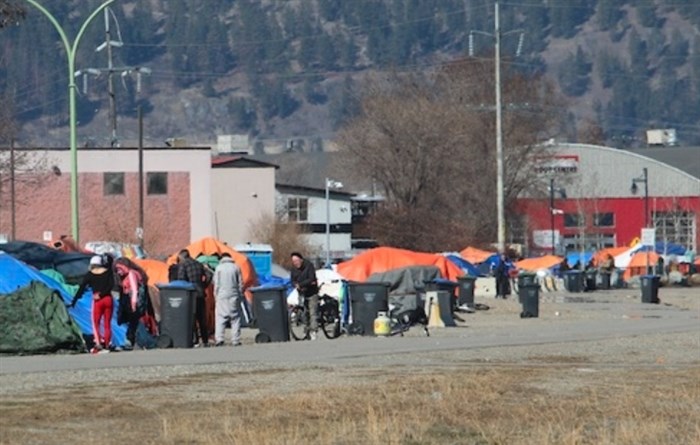Overcrowding making tent city part of Kelowna’s Rail Trail experience

There’s nothing much more beautiful than a walk or cycle down the Okanagan Rail Trail along the shore of sparkling, multi-coloured Kalamalka Lake.
But travel further south on the trail to near where it ends at Okanagan Lake and it’s a different world altogether — lined with dozens of tents and camping areas that are becoming permanent or long-term shelters.
It wasn’t supposed to be this way when the City of Kelowna moved its “ temporary outdoor overnight sheltering site” next to the Rail Trail near Richter Street two years ago.
“It was built for 40 or 50,” Ken Hunter, the city’s bylaw services supervisor, told iNFOnews.ca. “We’ve been well beyond that for some time.”
There are now 60 to 100 people camping there each night.
READ MORE: Okanagan society working to keep people out of shelters one landlord at a time
The sheltering site was designed to be contained behind a fence with strategically placed boulders separating it from the Rail Trail.
Now it has expanded in both directions away from that site but, mostly, to the east.
The original requirement that tents be taken down each morning and not set up again until well into the evening has vanished.
“With those kinds of numbers there, it just isn’t feasible,” Hunter said. “We do attempt, as much as we can, to keep them light. We don’t let them accumulate unnecessary items and try to make them so, if they need to be mobile, they can be in a short period of time.”
When iNFOnews.ca visited the area at noon earlier this week there were about 40 tents strung along the south side of the Rail Trail. Many were large and appeared quite settled in.
“The other thing that goes with that is, if we do have them decamp, where do they go and what services are available for them and where do they spend their day?” Hunter said. “That impacts the larger community and impacts our non-profit partners. Although we would like them to decamp daily, that’s not always practical.”
Many of the residents have been there much of the winter but, as the weather warms, more new faces are arriving, he said.
The warmer weather also means that more people are opting to camp out rather than go into emergency shelters. Those shelters are now running at 90-91% capacity, Stephanie Gauthier, executive director of the Journey Home Society said.
For example, on one day earlier this week, there were 24 available shelter beds out of the 273 offered nightly.
Without more housing or rent subsidies, the numbers of people sleeping rough is expected to grow by about 100 more before next winter, Gauthier said.
READ MORE: Kamloops, Kelowna could learn about housing affordability from this Lower Mainland city
The tenting site is only one area homeless people are staying.
City bylaw officers do an early morning count each morning and find another 40 or 50 people camped out in other parts of the city every day.
The largest numbers are in the 200-400 block of Leon Avenue but other popular areas are Lions Park in Rutland and around the Columbia Bottle Depot in Midtown, Hunter said.
“We’re not finding them in the (downtown) parks, which is a good thing,” he said. “We don’t want them in our parks like Kerry Park or City Park, which are sort of our crown jewels. We really discourage them from being in there and they seem to get that.
“They spring up in various locations around the city and, of course, if they’re in an area that’s grabbing a lot of public attention and it’s not safe, we’ll certainly address those areas and get them decamped and encourage them to go to the sheltering site rather than using other locations.”
The daily count, he noted, is focussed on key areas where people are easily spotted.
“That’s not an accurate number,” Hunter said. “It’s just the ones that are obviously homeless to our officers in a general surveillance of the city without going deep into the woods or anything like that. We’re aware there’s probably a population of them we don’t see.”
The officers are particularly vigilant about fire hazards in tents, like propane bottles. They have put out some warming fires but, fortunately, there have not been any fatalities from fires this winter.
Fire department officials frequently check out the sheltering site, Hunter said.
Similarly, there have not been any overdose deaths in the tenting site, although bylaw officers have had to administer naloxone at times.
RCMP have been called to deal with potentially violent situations but, again, there have been no serious incidents.
“All of this has to be managed by our officers on a daily basis to mitigate the ongoing problems – not only for the safety of our citizens but also for the safety of our homeless community partners,” Hunter said.
To contact a reporter for this story, email Rob Munro or call 250-808-0143 or email the editor. You can also submit photos, videos or news tips to the newsroom and be entered to win a monthly prize draw.
We welcome your comments and opinions on our stories but play nice. We won't censor or delete comments unless they contain off-topic statements or links, unnecessary vulgarity, false facts, spam or obviously fake profiles. If you have any concerns about what you see in comments, email the editor in the link above.



